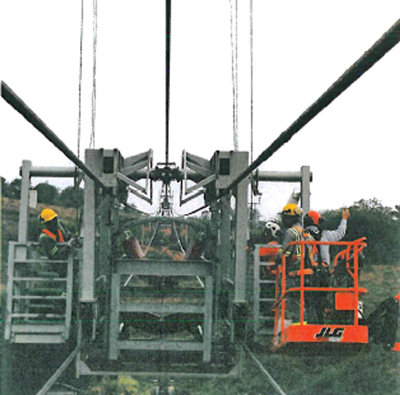 |
| The longest Flyingbelt system, pictured here, stretches 7.2 km and is supported by 18 towers. It runs at a speed of 4 m/s. |
Environmental impact reduction, energy efficiency, cost reduction, CO2 emission reductions—all are issues getting increased attention from the global mining industry, and each can be addressed by some of the latest developments in innovative raw material transportation systems.
As Stefano Cattaneo, sales and marketing manager for Agudio S.p.A., pointed out, raw material transportation is an aspect of mineral production that often has an easy solution—but not always: Suppose an operation requires a haulage road that must bypass an ecological preserve area, or if the shortest route between mine and plant crosses a deep valley or a river? Is the best solution to operate a large truck fleet, hauling materials over a distance that could be many times longer than the shortest way?
Agudio is an Italian company, founded in 1861 and now part of the Poma-Leitner Group, specializing in engineering and construction of customized, unconventional transportation systems using cables, such as material ropeways, conveyor belts suspended from cables and cable cranes. In a recent instance, a customer came to Agudio with a specific request for a mine-to-plant bulk transport system. The solution would require design of a belt-based system that could provide high capacity (1,500 t/h), work around a number of geological and environmental constraints, have no fencing and/or surveillance along the line, yet provide convenient inspection and maintenance access. The situation pointed to the need for a “suspended” solution with no intermediate stations along the route.
Agudio’s proposed solution took the form of a 7.2-km-long “Flyingbelt”—its patented raw material transportation system combining the advantages of a conveyor belt with a ropeway suspension system. Installation of a Flyingbelt could offer a number of benefits, including:
• Low environmental impact – It requires considerably fewer supporting structures—at variable distances up to 1,000 m—than a standard conveyor belt, with visual and CO2 emissions considerably reduced when compared with truck haulage.
• Flexible route design – It can be adapted to problematic terrains, overcoming obstacles and able to make horizontal bends.
• Reduced capex – Components are standard conveyor belt parts, along with other modular parts specifically designed for simple and rapid assembly that can be conducted via a special installation vehicle running on the tracking ropes.
• Reduced opex and maintenance costs – Energy consumption is lower when compared with other solutions, and maintenance can be done “online.”
• Energy efficiency – Compared wit conventional truck transportation, Flyingbelt is more efficient, energy requirements are low and, in some cases, can provide regenerative power.
 |
| The system’s maintenance and inspection cars travel along the tracking ropes. |
Design efforts resulted in the longest Flyingbelt in the world, composed of a single belt length of 14.4 km running from the loading station to the unloading station (both designed by Agudio), suspended by four segments of tracking ropes and 18 supporting towers. The system runs at a speed of 4 m/s. Visual inspection and maintenance is conducted using four maintenance vehicles designed in accordance with stringent human-transportation standards.
Energy reduction using this system is significant, according to the company. With conventional truck transport of 4.5 million t/y of raw material, assuming a distance of 25 km between the mine site and plant and a one-hour cycle time, annual CO2 emissions are estimated at 8,500 t/y. The Flyingbelt installation, however, will consume power at a rate of 1,400 kWh for 3,000 hr/y during operation and, taking into consideration all factors, will generate CO2 emission of about 375 t/y—resulting in a net reduction of 8,125 t/y, or more than 95%.






